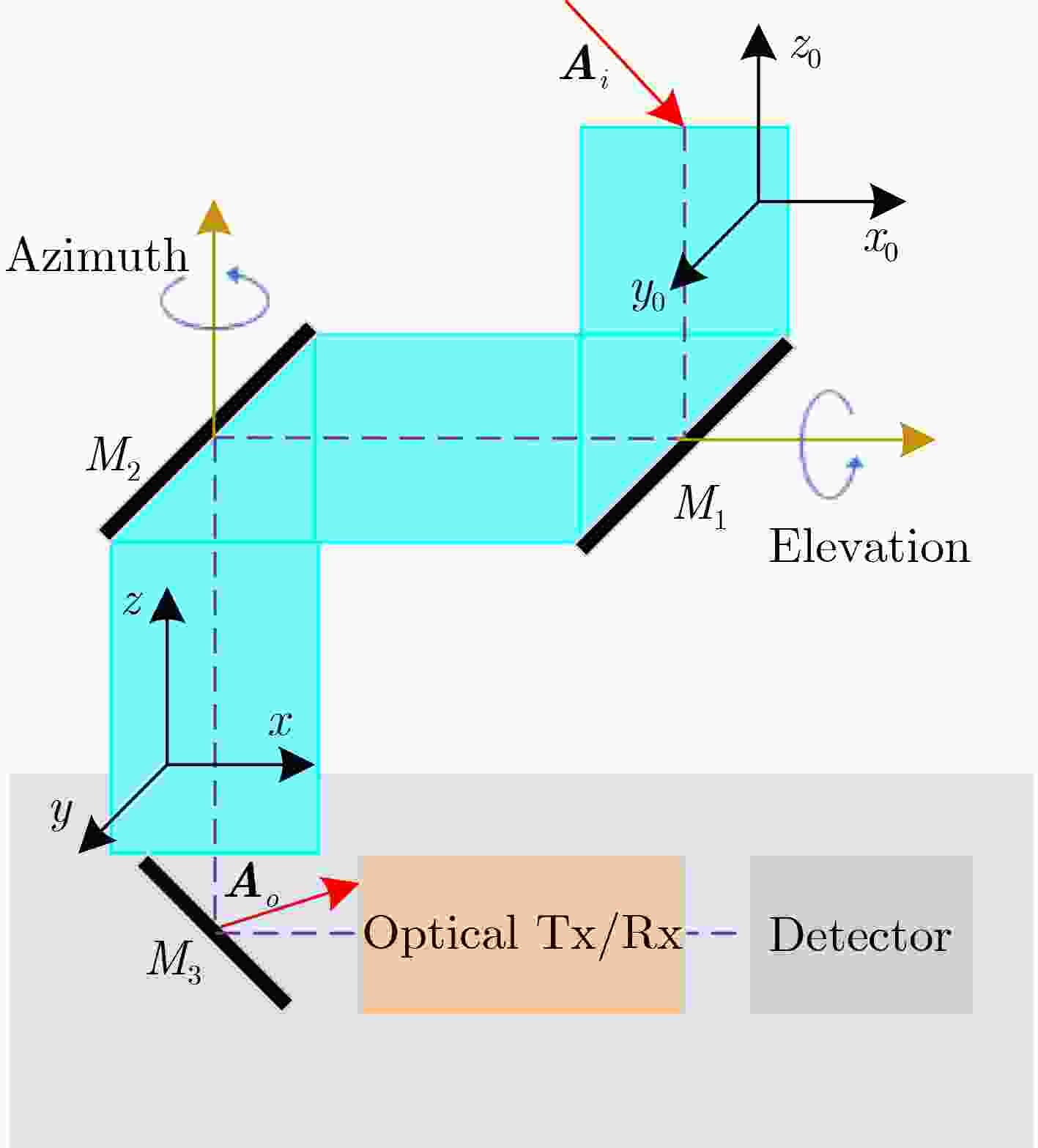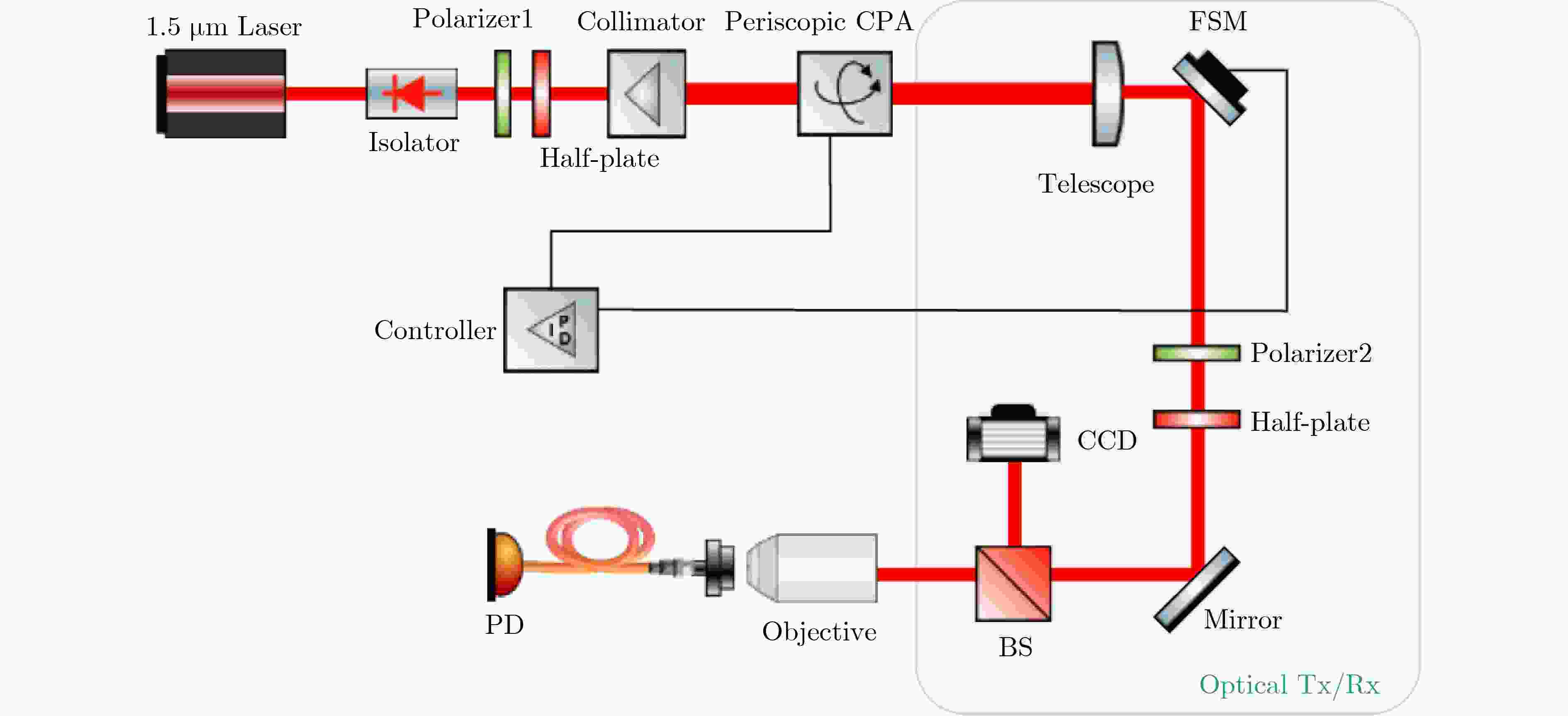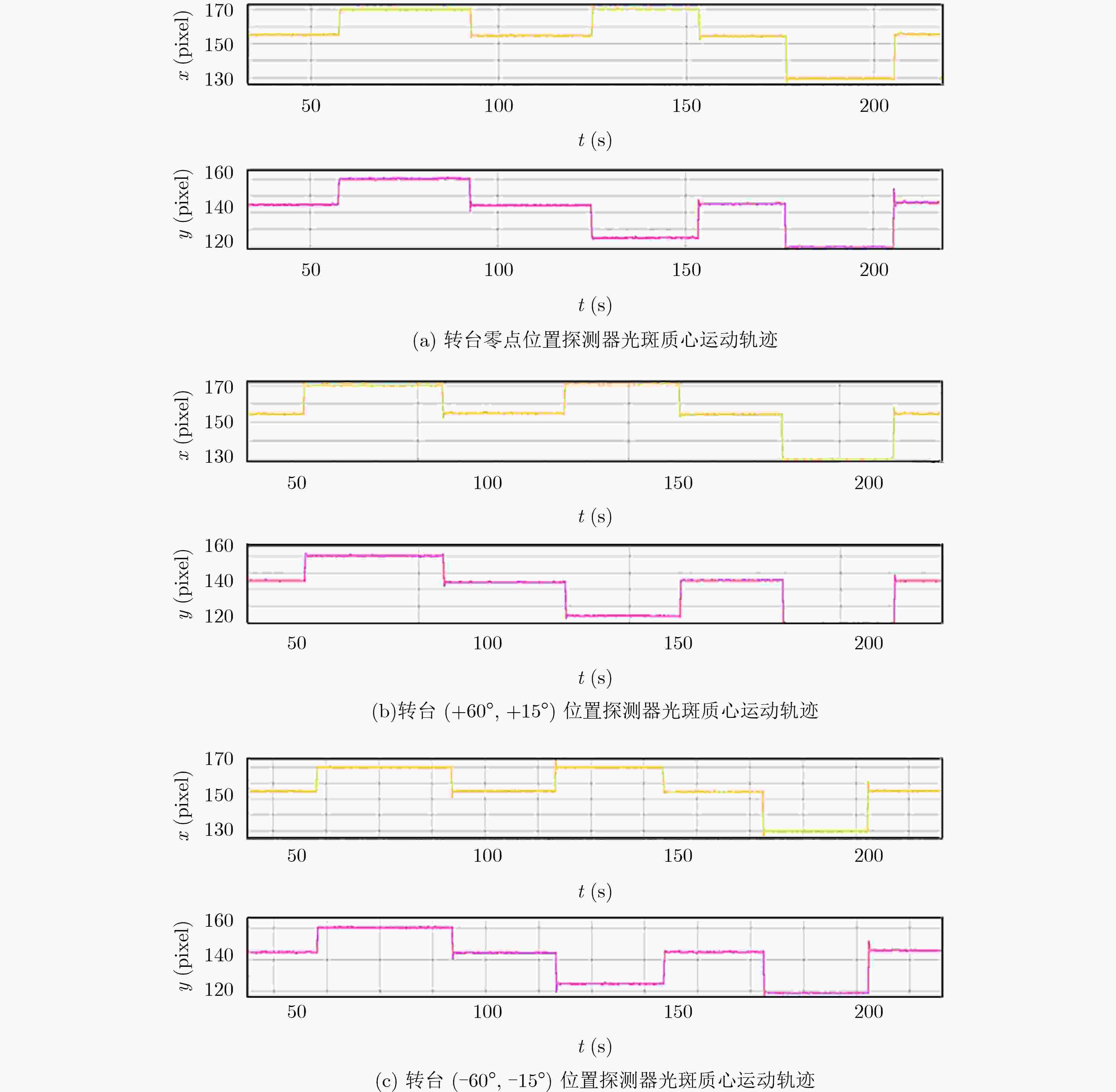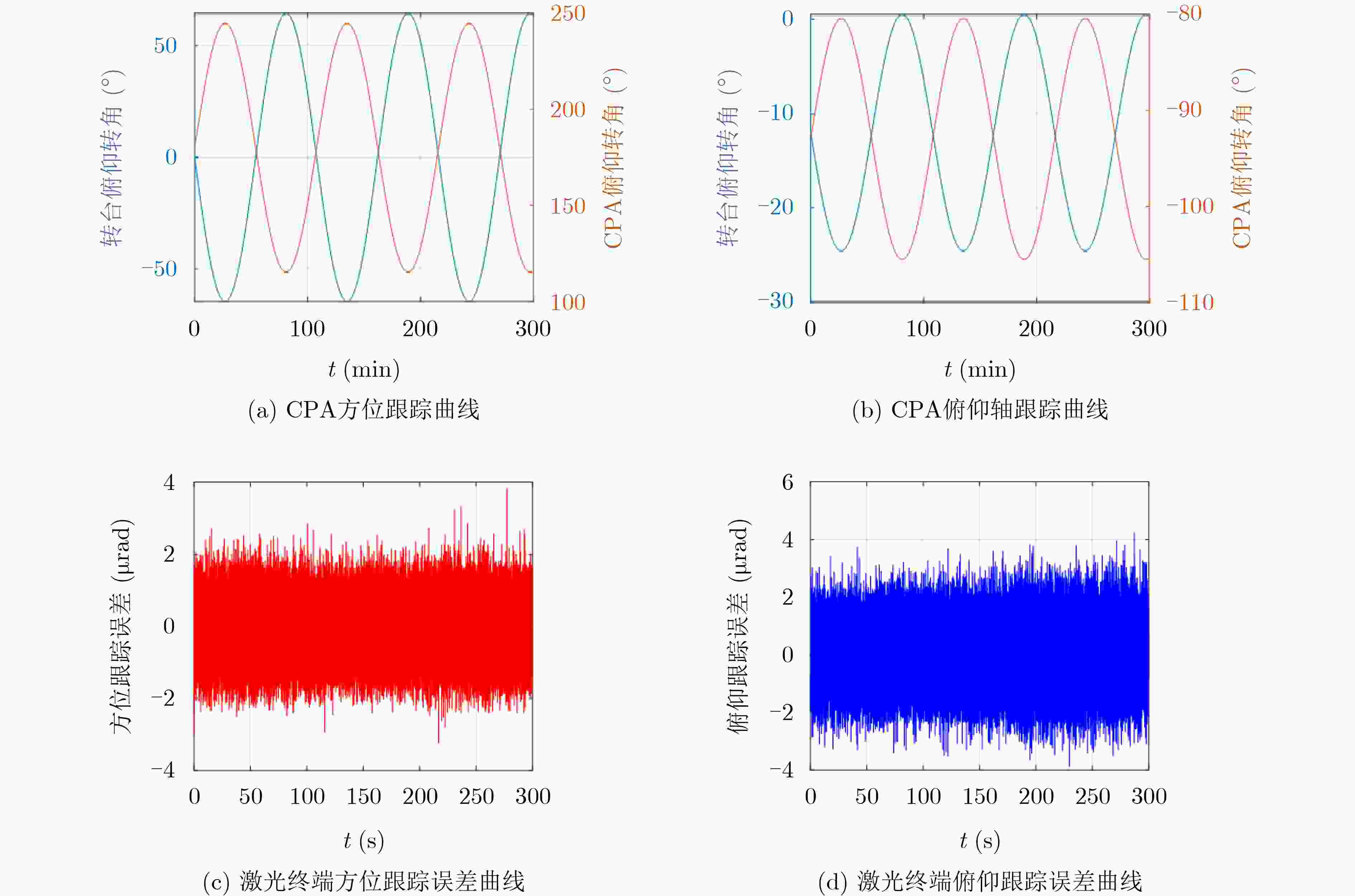Full Field-of-View Optical Calibration with Microradian-Level Accuracy for Space Laser Communication Terminals on Low-Earth-Orbit Constellation Applications
-
摘要: 星间激光通信因其具有超大信道容量、极低传输损耗和物理层高安全性,已成为下一代低轨巨型星座实现全球高速数据传输的核心技术。然而,低轨卫星的高速相对运动与复杂轨道摄动,对激光终端的快速建链与稳定跟踪构成了严峻挑战。为实现稳定可靠的通信链路,必须在全空间范围内建立粗指向机构(CPA)与探测器间微弧度量级的光学标定关系。该文提出一种面向低轨星座的全视场微弧度级光学标定方法,将复杂光机耦合误差统一建模为线性映射关系,利用CPA的随机微扰动运动构建其转角微偏移量与探测器光斑位移间的共轭关系,从而精确估计光学标定矩阵。实验结果表明,该方法可有效抑制光学像旋、跨象限运动、异常跟踪及镜像等系统误差,全空间跟踪精度优于5 μrad,显著提升了终端动态跟踪性能。Abstract:
Objective The Coarse Pointing Assembly (CPA) is a core element in laser communication systems and supports wide-field scanning, active orbit–attitude compensation, and dynamic disturbance isolation. To address multi-source disturbances such as orbital perturbations and attitude maneuvers, a high-precision, high-bandwidth, and fast-response Pointing, Acquisition, and Tracking (PAT) algorithm is required. Establishing a full Field-Of-View (FOV) optical calibration model between the CPA and the detector is essential for suppressing image degradation caused by spatial pointing deviations. Conventional calibration methods often rely on ray tracing to simulate beam offsets and infer calibration relationships, yet they show several limitations. These limitations include high modeling complexity caused by non-coaxial paths, multi-reflective surfaces, and freeform optics; susceptibility to systematic errors generated by assembly tolerances, detector non-uniformity, and thermal drift; and restricted applicability across the full FOV due to spatial anisotropy. A high-precision calibration method that remains effective across the entire FOV is therefore needed to overcome these challenges and ensure stable and reliable laser communication links. Methods To achieve precise CPA–detector calibration and address the limitations of traditional approaches, this paper presents a full FOV optical calibration method with microradian-level accuracy. Based on the optical design characteristics of periscope-type laser terminals, an equivalent optical transmission model of the CPA is established and the mechanism of image rotation is examined. Leveraging the structural rigidity of the optical transceiver channel, the optical transmission matrix is simplified to a constant matrix, yielding a full-space calibration model that directly links CPA micro-perturbations to spot displacements. By correlating the CPA rotation angles between the calibration target points and the actual operating positions, the calibration task is further reduced to estimating the calibration matrix at the target points. Random micro-perturbations are applied to the CPA to induce corresponding micro-displacements of the detector spot. A calibration equation based on CPA motion and spot displacement is formulated, and the calibration matrix is obtained through least-squares regression. The full-space calibration relationship between the CPA and detector is then derived through matrix operations. Results and Discussions Using the proposed calibration method, an experimental platform ( Fig. 4 ) is constructed for calibration and verification with a periscope laser terminal. Accurate measurements of the conjugate motion relationship between the CPA and the CCD detector spot are obtained (Tab. 1 ). To evaluate calibration accuracy and full-space applicability, systematic verification is conducted through single-step static pointing and continuous dynamic tracking. In the static pointing verification, the mechanical rotary table is moved to three extreme diagonal positions, and the CPA performs open-loop pointing based on the established CPA–detector calibration relationship. Experimental results show that the spot reaches the intended target position (Fig. 5 ), with a pointing accuracy below 12 mrad (RMS). In the dynamic tracking experiment, system control parameters are optimized to maintain stable tracking of the platform beam. During low-angular-velocity motion of the rotary table, the laser terminal sustains stable tracking (Fig. 6 ). The CPA trajectory shows a clear conjugate relationship with the rotary table motion (Fig. 6(a) ,Fig. 6(b) ), and the tracking accuracy in both orthogonal directions is below 4 mrad (Fig. 6(c) ,Fig. 6(d) ). The independence of the optical transmission matrix from the selection of calibration target points is also examined. By increasing the spatial accessibility of calibration points, the method reduces operational complexity while maintaining calibration precision. Improved spatial distribution of calibration points further enhances calibration efficiency and accuracy.Conclusions This paper presents a full FOV optical calibration method with microradian-level accuracy based on single-target micro-perturbation measurement. To satisfy engineering requirements for rapid linking and stable tracking, a full-space optical matrix model for CPA–detector calibration is constructed using matrix optics. Random micro-perturbations applied to the CPA at a single target point generate a generalized transfer equation, from which the calibration matrix is obtained through least-squares estimation. Experimental results show that the model mitigates image rotation, mirroring, and tracking anomalies, suppresses calibration residuals to below 12 mrad across the full FOV, and limits the dynamic tracking error to within 5 mrad per axis. The method eliminates the need for additional hardware and complex alignment procedures, providing a high-precision and low-complexity solution that supports rapid deployment in the mass production of Low-Earth-Orbit (LEO) laser terminals. -
Key words:
- Laser terminal /
- Micro-perturbation /
- Calibration /
- Coarse Pointing Assembly(CPA)
-
表 1 CPA和光斑位移共轭运动实验测试结果
次数 △cpaxj/LSB △cpayj/LSB △xj/pixel △yj/pixel 1 –350 –150.30 –3.6 –8.4 2 300 125.25 3.0 7.2 3 –125 450.90 10.8 –3.0 4 150 225.45 5.4 3.6 -
[1] KODHELI O, LAGUNAS E, MATURO N, et al. Satellite communications in the New Space Era: A survey and future challenges[J]. IEEE Communications Surveys & Tutorials, 2021, 23(1): 70–109. doi: 10.1109/COMST.2020.3028247. [2] SINGYAP K and ALOUINI M S. Performance of UAV-assisted multiuser terrestrial-satellite communication system over mixed FSO/RF channels[J]. IEEE Transactions on Aerospace and Electronic Systems, 2022, 58(2): 781–796. doi: 10.1109/TAES.2021.3111787. [3] BRASHEARS T R. Achieving ⪆99% link uptime on a fleet of 100G space laser inter-satellite links in LEO[C]. SPIE 12877, Free-Space Laser Communications XXXVI, San Francisco, CA, USA, 2024: 1287702. doi: 10.1117/12.3005057. [4] 许维翰, 周林杰, 陈建平. 硅基波导集成光学相控阵芯片—设计难点与突破(特邀)[J]. 光学学报, 2024, 44(15): 1513026. doi: 10.3788/AOS241072.XU Weihan, ZHOU Linjie, and CHEN Jianping. Silicon-based waveguide integrated optical phased array chips for LiDAR: Design challenges and breakthroughs (invited)[J]. Acta Optica Sinica, 2024, 44(15): 1513026. doi: 10.3788/AOS241072. [5] LI Jie, LUO Ming, HU Leilei, et al. Real-time 200Gbps coherent PON based on silicon photonic integrated transceiver[C]. 2022 Asia Communications and Photonics Conference, Shenzhen, China, 2022: 957–960. doi: 10.1109/ACP55869.2022.10088953. [6] HE Jingwen, DONG Tao, and XU Yue. Review of photonic integrated optical phased arrays for space optical communication[J]. IEEE Access, 2020, 8: 188284–188298. doi: 10.1109/ACCESS.2020.3030627. [7] XUE Wenli, LIU Yichen, ZHU Xingwang, et al. A high-performance 10 mm diameter MEMS fast steering mirror with integrated piezoresistive angle sensors for laser inter-satellite links[J]. Microsystems & Nanoengineering, 2025, 11(1): 75. doi: 10.1038/s41378-025-00935-1. [8] WEN Zhidong, HOU Yu, CHEN Yang, et al. Improved acquisition performance of inter-satellite laser communication system through non-mechanical adaptive beam control[J]. Optics and Lasers in Engineering, 2025, 194: 109217. doi: 10.1016/j.optlaseng.2025.109217. [9] 李锐, 林宝军, 刘迎春, 等. 激光星间链路发展综述: 现状、趋势、展望[J]. 红外与激光工程, 2023, 52(3): 20220393. doi: 10.3788/IRLA20220393.LI Rui, LIN Baojun, LIU Yingchun, et al. Review on laser intersatellite link: Current status, trends, and prospects[J]. Infrared and Laser Engineering, 2023, 52(3): 20220393. doi: 10.3788/IRLA20220393. [10] GUELMAN M, KOGAN A, KAZARIAN A, et al. Acquisition and pointing control for inter-satellite laser communications[J]. IEEE Transactions on Aerospace and Electronic Systems, 2004, 40(4): 1239–1248. doi: 10.1109/TAES.2004.1386877. [11] 侯霞, 刘哲绮, 常亦迪, 等. 卫星激光通信技术发展现状与趋势分析[J]. 中国激光, 2024, 51(11): 1101013. doi: 10.3788/CJL240448.HOU Xia, LIU Zheqi, CHANG Yidi, et al. Analysis on development status and trend of space laser communication technology[J]. Chinese Journal of Lasers, 2024, 51(11): 1101013. doi: 10.3788/CJL240448. [12] LIU Cheng, WEN Feng, and FAN Feng. Pointing, acquisition, and tracking (PAT) technology for inter-satellite laser links[C]. SPIE 13492, AOPC 2024: Laser Technology and Applications, Beijing, China, 2024: 134920C. doi: 10.1117/12.3046162. [13] NIELSEN T T. Pointing, acquisition, and tracking system for the free-space laser communication system SILEX[C]. SPIE 2381, Free-Space Laser Communication Technologies VII, San Jose, CA, USA, 1995. doi: 10.1117/12.207403. [14] FIELDS R, LUNDE C, WONG R, et al. NFIRE-to-TerraSAR-X laser communication results: Satellite pointing, disturbances, and other attributes consistent with successful performance[C].SPIE 7330, Sensors and Systems for Space Applications III, Orlando, FL, USA, 2009: 73300Q. doi: 10.1117/12.820393. [15] CARRASCO-CASADO A, SHIRATAMA K, TRINH P V, et al. Development of a miniaturized laser-communication terminal for small satellites[J]. Acta Astronautica, 2002, 197: 1–5. doi: 10.1016/j.actaastro.2022.05.011. [16] WANG Xuan, HAN Junfeng, WANG Chen, et al. Beam scanning and capture of micro laser communication terminal based on MEMS micromirrors[J]. Micromachines, 2023, 14(7): 1317. doi: 10.3390/mi14071317. [17] RÜDDENKLAU R, REIN F, ROUBAL C, et al. In-orbit demonstration of acquisition and tracking on OSIRIS4CubeSat[J]. Optics Express, 2024, 32(23): 41188–41200. doi: 10.1364/OE.537889. [18] ZHANG Furui, HAN Junfeng, and RUAN Ping. Beam pointing analysis and a novel coarse pointing assembly design in space laser communication[J]. Optik, 2019, 189: 130–147. doi: 10.1016/j.ijleo.2019.05.079. [19] MILLER E D, DESPENZA M, GAVRILYUK I, et al. A prototype coarse pointing mechanism for laser communication[C]. SPIE 10096, Free-Space Laser Communication and Atmospheric Propagation XXIX, San Francisco, CA, USA, 2017: 100960S. doi: 10.1117/12.2264086. [20] 谭立英, 吴世臣, 韩琦琦, 等. 潜望镜式卫星光通信终端的CCD粗跟踪[J]. 光学 精密工程, 2012, 20(2): 270–276. doi: 10.3788/OPE.20122002.0270.TAN Liying, WU Shichen, HAN Qiqi, et al. Coarse tracking of periscope-type satellite optical communication terminals[J]. Optics and Precision Engineering, 2012, 20(2): 270–276. doi: 10.3788/OPE.20122002.0270. [21] 张家齐, 张立中, 董科研, 等. 二次成像型库德式激光通信终端粗跟踪技术[J]. 中国光学, 2018, 11(4): 644–653. doi: 10.3788/CO.20181104.0644.ZHANG Jiaqi, ZHANG Lizhong, DONG Keyan, et al. Coarse tracking technology of secondary imaging Coude-type laser communication terminal[J]. Chinese Optics, 2018, 11(4): 644–653. doi: 10.3788/CO.20181104.0644. -






 下载:
下载:







 下载:
下载:
